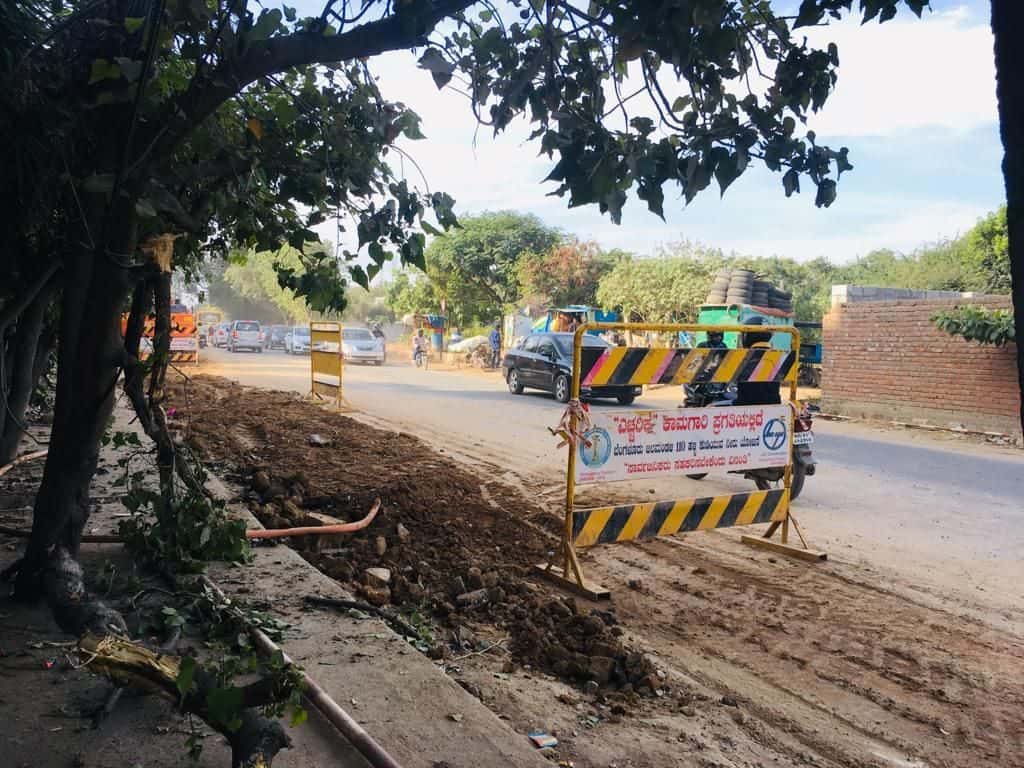Ananya (name changed) is a resident who lives near Sarjapur Road. She finds her daily walk along Sarjapur Road an arduous ritual. “Trying to cross these roads, especially during the morning rush hour, is nerve-wracking,” she says. “I’ve come close to being hit by vehicles who don’t slow down so that [pedestrians] can cross, or decide to speed too close where we walk. Once that’s done, I need to pick my way through broken bits of the pavement and open gutters before I reach my bus stop.”

BWSSB work in progress on Harlur Road, rendering the footpath and parts of the road unwalkable. Pic: Meera K
Residents and pedestrians on Sarjapur Road look danger in the eye when they walk on the unpaved sides of the busy main road; traffic doesn’t seem to care that they exist. A large number of people need to cross the road on a daily basis between the bus stops at Iblur Junction, but the only place that one can cross at is at the widening of a bottle-neck on both roads, making it additionally dangerous.
Crossing over from Iblur Lake towards Columbia Asia is extremely risky as there are no pedestrian crossings. One navigates speeding traffic, encroached footpaths and pelican signals, to walk the span of the road. It becomes additionally difficult for the elderly and disabled. There have been several accidents involving pedestrians on this road, some of which have even been fatal.

BWSSB work at progress on Harlur Road, off Sarjapur Road. Pic: Meera K
In early December, Gangadhar Nair, a 75-year-old man on his way to Columbia Asia hospital lost his life after being hit by a BMTC bus. Before that, 20-year-old Sunil Vishwakarma had been run over by another BMTC bus while he was waiting on road, as the footpath was encroached. It took the death of 19 year-old Sanjay Giri to erect a skywalk in Bellandur.
There is a severe dearth of pedestrian infrastructure such as footpaths, zebra crossings, high rise pedestrian crossings (HPRC), skywalks or at the very least, traffic police to help pedestrians cross the busy road. Footpaths are encroached by parked vehicles, street vendors and construction debris. Vehicles drive on the opposite side of the road at high speeds, without a care or concern in the world for the safety of the people walking on those roads. Drains are left uncovered for the unsuspecting pedestrian or even vehicle to fall into.
“Drain covers need to be built along the style of what ORR has,” said Mukund Kumar, who has been involved in civic activism since 2012. “One of the challenges I see is to ensure continuity of the drain foot path. I don’t see road widening happening and hence, a wide foot path seems like a distant reality.”

Recently constructed island for pedestrian crossing at Iblur Junction. Pic: Rahna Jacob
This unfriendly architecture and government apathy has already taken its toll in the forms of lives being lost, which could have easily been avoided. The members of Bellanduru Jothege have proposed a plan to the BBMP to ensure pedestrian safety, which includes increasing the duration of traffic signals by 15-20 seconds, grills on footpaths to prevent rash drivers from harming pedestrians among other things. The BBMP is currently working to implement these plans, and has finished constructing an island to facilitate ease of crossing.
“The pedestrian island is a place where people crossing the large stretch of the road can stop safely,” said Gopinath, a traffic policeman who mans the Iblur Junction. “Ever since it has been installed, we have noticed that pedestrians – senior citizens in particular – have been able to cross with greater ease,” he added.
On asking if there were any more changes to come, he said that the current situation would be assessed for some more time, and plans would then be made accordingly.
Life is pathetic in Bangalore
All roads dug up everywhere
No one follows traffic rules
No footpaths
No pedistrian crossing
Traffic jams everywhere
In rains water clogs all roads in Outer Ring Road and surrounding
No water to drink
And we want to call this the Silicon Valley of east
If someone moves all companies to some other state/city and no one will want to live in Bangalore
Pathetic quality of living